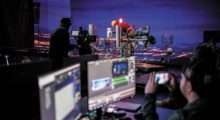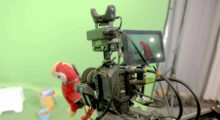virtual production
-
Vu One: Vu’s New All-in-One Virtual Production Studio

Vu just announced a new product that aims to make virtual production a lot more accessible: the Vu One. It’s two parts. One part turnkey virtual production studio in a (very, very, big) box. One part Vu’s Virtual Studio, a software platform that makes creating and running virtual scenes a lot easier. Let’s break down both parts. Complete Virtual Production Setup Vu One offers a complete, configurable VP setup, which includes: LED Wall by Unilumin, with sizing starting at 13×9 ft Media Server by Puget Systems LED Processor by Megapixel Stereoscopic camera tracker (more on that below) Optional camera tracker […]
by Joey Daoud on Sep 6, 2023 -
Reaching the Peak: Exploring Virtual Production on an Independent Budget

Given our tech-driven and communication-obsessed culture, it’s highly likely that you’re reading this article while multitasking on your smartphone. But as is the case with so many commodity industries like data, the true cost of all this connectivity often eludes us. This disconnect is what drove us to write the film HIGH, set in the fascinating and rarely seen world of telecom tower climbers. In the aftermath of a tragic accident, team foreman Butch Robbins leads his crew through the brutal Buffalo winter to finish their job on deadline and save the company, all without losing the connection he needs […]
by Jonathan Mason and Tisha Robinson-Daly on Jun 27, 2023 -
NAB 2023: New Gear That’s Making Virtual Production More Affordable and Accessible

At NAB I had a mission: find out what new products are making virtual production more affordable, more accessible, and not require a master’s degree in Unreal. Fortunately, I found a few options. Plus some new tools that are blending generative AI with virtual production. Let’s dig into what’s new in VP from NAB. Budget-Friendly Virtual Production First is the VIVE Mars CamTrack—a complete package for creating an affordable virtual volume. HTC’s VIVE has been in the virtual reality space for a while, with some of the top VR headsets. They also make the VIVE Tracker, a palm-sized puck that can track […]
by Joey Daoud on May 23, 2023 -
Speaking Volumes: The Production Benefits and Challenges of Shooting on Virtual Stages
For Metropolis special effects artist Eugen Schüfftan, a model, a mirror and a sharp-edged tool were all the instruments required to create cinematic wonder in the 1920s. The mirror—placed at a 45-degree angle in front of the camera—reflected the image of a model cityscape located just out of frame. The tool then scraped away sections of the mirror’s reflective layer, leaving only glass and revealing strategically placed actors in the distance. When the mirror was filmed, the citizens of Metropolis now magically appeared to inhabit the colossal urban dystopia. A century later, virtual production is the latest evolution in cinematic […]
by Matt Mulcahey on Mar 16, 2023



